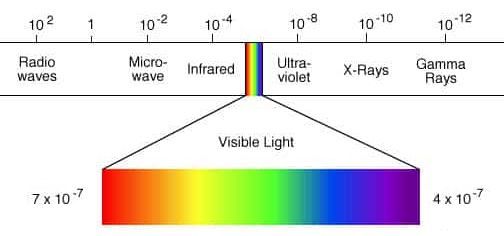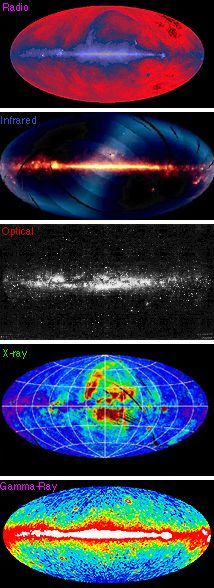Methods of observation
L'observation du ciel est la base de l'astronomie. Au fil du temps, les chercheurs ont développé des méthodes de plus en plus sophistiquées pour obtenir directement ou indirectement des informations sur l'univers.

Observer les ondes électromagnétiques
Au fil des siècles, les astronomes ont développé des télescopes de plus en plus performants afin de collecter des informations sur l'univers. Aujourd'hui, les télescopes sont installés dans des observatoires sur la Terre et voyagent dans l'espace sur des satellites. Ces derniers permettent également de prendre des photos d'objets extrêmement éloignés comme les galaxies (naissantes).
Les télescopes se distinguent surtout par la longueur d'onde du rayonnement électromagnétique qu'ils utilisent pour les observations. Avec l'œil humain, nous ne pouvons capter qu'une partie très limitée du rayonnement électromagnétique présent dans l'espace - la lumière dont la longueur d'onde est comprise entre 380 et 780 nanomètres.
- La radioastronomie travaille avec des longueurs d'onde allant de quelques millimètres à des centaines de kilomètres.
- L'astronomie optique travaille dans le domaine de la lumière visible de 380 à 780 nanomètres.
- L'astronomie infrarouge observe des longueurs d'onde comprises entre 700 nanomètres et 300 micromètres,
- L'astronomie ultraviolette observe des longueurs d'onde comprises entre 10 et 380 nanomètres et
- L'astronomie des rayons X et l'astronomie gamma. L'astronomie des rayons X détecte les rayonnements dont la longueur d'onde est comprise entre 10 picomètres et 10 nm et l'astronomie gamma détecte tout ce qui est inférieur à 10 picomètres.
Depuis la Terre, les chercheurs ne peuvent observer que les ondes optiques, infrarouges et radio. L'atmosphère terrestre absorbe tous les autres rayons. Pour observer les rayons ultraviolets, les rayons gamma ou les rayons X, par exemple, il faut des télescopes sur des satellites.
La situation est très différente selon la longueur d'onde à laquelle le télescope est destiné. Alors que nous pouvons concentrer le rayonnement optique avec des lentilles en verre ou en plastique, par exemple dans une lunette astronomique, les longueurs d'ondes radio nécessitent de grandes antennes paraboliques. Pour les rayons dans le domaine des rayons X et des rayons gamma, il faut des miroirs spécialement disposés.
Examiner les particules
Outre les ondes électromagnétiques, les chercheurs peuvent également étudier les particules qui nous parviennent de l'espace. Les rayons cosmiques se composent principalement de protons, d'électrons et de noyaux atomiques individuels. Les explosions de supernovae produisent en outre des neutrinos cosmiques qui parviennent jusqu'à la Terre.



